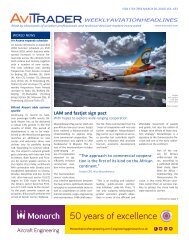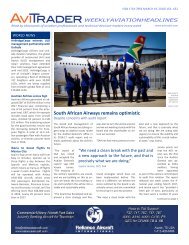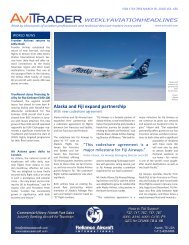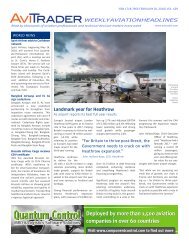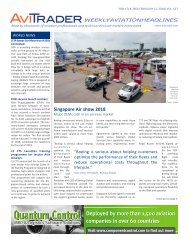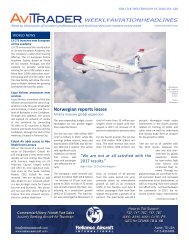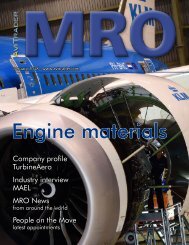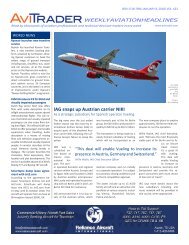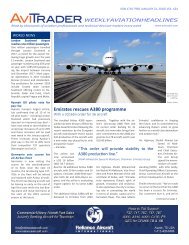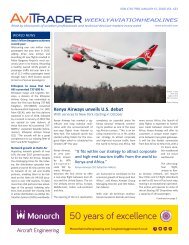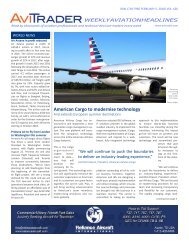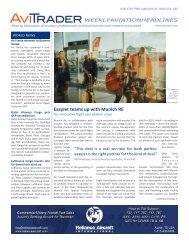AviTrader_Monthly_MRO_e-Magazine_2016-03
AviTrader_Monthly_MRO_e-Magazine_2016-03
AviTrader_Monthly_MRO_e-Magazine_2016-03
Create successful ePaper yourself
Turn your PDF publications into a flip-book with our unique Google optimized e-Paper software.
Cover story: APU maintenance<br />
23<br />
Maintaining APUs<br />
In 1963 the Boeing 727 was the first jetliner to introduce a gas Auxiliary Power Unit (APU). They remain a<br />
critical part of aircraft systems and so is the maintenance and repair process. Keith Mwanalushi reports.<br />
APUs provide secondary power for main<br />
engine starting, cabin air conditioning and<br />
electric power for aircraft while on the<br />
ground and can also provide electric power during<br />
in-flight operation.<br />
The role of APUs is even more crucial in the event<br />
the main power systems fail. The Honeywell 131-<br />
9 APU was used in an emergency landing when<br />
U.S. Airways Flight 1549 splash landed in New<br />
York City’s Hudson River in 2009. Both CFM56<br />
turbofans on the A320 were damaged and electrical<br />
generators went off line.<br />
According to ATC Aerospace depending on the<br />
design, the APU can provide electric power, hydraulic<br />
power, pneumatic power or all three.<br />
Connecting to a hydraulic pump allows the crew<br />
to operate hydraulic equipment such as the flight<br />
controls or flaps. Having this function is also useful<br />
for a backup if there is an engine failure.<br />
The typical APU on a commercial airliner is comprised<br />
of three main sections:<br />
Power Section: This is the gas generator part of the<br />
engine and gives power to the shaft of the APU.<br />
Load Compressor Section: This is a compressor<br />
mounted on the shaft. It provides pneumatic<br />
power to the aircraft. It has two actuated devices,<br />
the inlet guide vanes which regulate airflow<br />
The main criteria that triggers removals will be performance.<br />
to the load compressor and the surge control<br />
valve which allows the surge-free operation of<br />
the turbo machine.<br />
Gearbox Section: This transfers power from the<br />
Photo: Joramco<br />
main shaft to an oil-cooled generator for electrical<br />
power. Inside the gearbox is where power is<br />
transferred to the engine accessories like the fuel<br />
control unit, the cooling fan and the lubrication<br />
module. There is also a starter motor connected<br />
through the gear train. It performs the starting<br />
function of the APU.<br />
The 787 Dreamliner, uses more electric power<br />
than the typical airliner so the APU is only used<br />
to deliver electricity to the aircraft. Not having a<br />
pneumatic system simplifies the design but the<br />
trade-off is the high demand for electricity meaning<br />
the requirement of heavier generators.<br />
Various elements have an impact on the maintenance required.<br />
Photo: AFI KLM<br />
Currently, experts at Lufthansa Technik see three<br />
main developments in the APU maintenance<br />
and repair business: Firstly, APU maintenance<br />
changed to FADEC (Full Authority Digital Engine<br />
Control) drives system with correct maintenance<br />
action to manage the on condition operation.<br />
Secondly, OEM’s have started to change the after<br />
sale market by choosing selected service providers.<br />
And lastly, the APU repair processes will be<br />
released from OEM to the selected service provider.<br />
Cost reduction for repair process versus<br />
damaged part replacement with pool or new<br />
material will be the challenge for the future.<br />
<strong>AviTrader</strong> <strong>MRO</strong> - March <strong>2016</strong>





